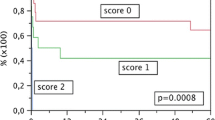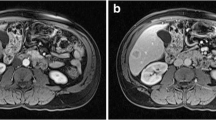Abstract
Model for Endstage Liver Disease (MELD) score has been used to allocate organs since February 2002. This policy allocates organs to candidates with regard to severity of their underlying liver disease except in the case of hepatocellular carcinoma (HCC) patients. The purpose of this study was to determine the impact of MELD on waiting times, dropout rates, and transplantation rates in all patients awaiting liver transplantation at our center. The records of all patients listed for liver transplantation between May 28, 1999, and February 27, 2004, at the Mayo Clinic, Scottsdale, Arizona, were reviewed. Candidates were grouped by two time periods as pre-MELD or post-MELD based on date of MELD implementation (February 27, 2002). The incidence of deceased donor liver transplantation (DDLT), waiting time to DDLT, dropout rate from the waiting list because of clinical deterioration or death, and survival while waiting for or after DDLT were determined for each group. Three hundred fifty-one patients were listed for liver transplantation (195 pre-MELD, 156 post-MELD) during the study period. HCC patients had an improved rate of transplantation after MELD (pre-MELD, 1.39 persons per year; post-MELD, 3.48 persons per year). In all groups, with the exception of hepatitis C virus, the transplantation rates were the same for both categories. The hepatitis C virus group also had improved transplantation rates in the post-MELD period. HCC candidates under the new allocation policy have an increased incidence of DDLT in our institution. However, this has not disadvantaged patients with non-HCC diagnoses. Thus, the new MELD-based allocation policy has benefited all candidates by allowing more timely transplants.
Similar content being viewed by others
References
1. Kamath PS, Wiesner RH, Malinchoc M, et al.: A model to predict survival in patients with end-stage liver disease. Hepatology 33:464–470, 2001
2. Malinchoc M, Kamath PS, Gordon FD, Peine CJ, Rank J, ter Borg PC: A model to predict poor survival in patients undergoing transjugular intrahepatic portosystemic shunts. Hepatology 31:864–871, 2000
3. Wiesner RH, McDiarmid SV, Kamath PS, et al.: MELD and PELD: application of survival models to liver allocation. Liver Transplant 7:567–580, 2001
4. Freeman RB Jr, Wiesner RH, Harper A, et al.: The new liver allocation system: moving toward evidence-based transplantation policy. Liver Transplant 8:851–858, 2002
5. Sharma P, Balan V, Hernandez JL, et al.: Liver transplantation for hepatocellular carcinoma: the MELD impact. Liver Transplant 10:36–41, 2004
6. Yao FY, Bass NM, Nikolai B, et al.: A follow-up analysis of the pattern and predictors of dropout from the waiting list for liver transplantation in patients with hepatocellular carcinoma: implications for the current organ allocation policy. Liver Transplant 9:684–692, 2003
7. Mazzaferro V, Regalia E, Doci R, et al.: Liver transplantation for the treatment of small hepatocellular carcinomas in patients with cirrhosis. N Engl J Med 334:693–699, 1996
8. United Network for Organ Sharing [homepage on the Internet]: Policy 3.6. Organ distribution allocation of livers. Updated 2003 November 21, cited 2004 July 21. Available at: http://www.unos.org/ policiesandbylaws/policies.asp?resources=true
9. United Network for Organ Sharing [homepage on the Internet]: Amendment to Policy 3.6.4.4. Organ distribution allocation of livers: liver transplant candidates with hepatocellular carcinoma (HCC). Updated 2003 November 21, cited 2004 July 21. Available at: http:// www.unos.org/policiesandbylaws/policies.asp?resources=true
10. OPTN/UNOS Liver and Intestinal Organ Transplantation Committee meeting. Modifications to the policy 3.6.4.4: liver candidates with hepatocellular carcinoma (HCC). 2003:2002. Available at: http://www.optn.org/policiesandbylaws/pdfs/policy_8.pdf
11. Hayashi PH, Trotter JF, Forman L, et al.: Impact of pretransplant diagnosis of hepatocellular carcinoma on cadaveric liver allocation in the era of MELD. Liver Transplant 10:42–48, 2004
12. Yamamoto J, Iwatsuki S, Kosuge T, et al.: Should hepatomas be treated with hepatic resection or transplantation? Cancer 86:1151–1158, 1999
13. Klintmalm GB: Liver transplantation for hepatocellular carcinoma: a registry report of the impact of tumor characteristics on outcome. Ann Surg 228:479–490, 1998
14. Otto G, Heuschen U, Hofmann WJ, Krumm G, Hinz U, Herfarth C: Survival and recurrence after liver transplantation versus liver resection for hepatocellular carcinoma: a retrospective analysis. Ann Surg 227:424–432, 1998
15. Bismuth H, Chiche L, Adam R, Castaing D, Diamond T, Dennison A: Liver resection versus transplantation for hepatocellular carcinoma in cirrhotic patients. Ann Surg 218:145–151, 1993
Author information
Authors and Affiliations
Corresponding author
Rights and permissions
About this article
Cite this article
Sachdev, M., Hernandez, J.L., Sharma, P. et al. Liver Transplantation in the MELD Era: A Single-Center Experience. Dig Dis Sci 51, 1070–1078 (2006). https://doi.org/10.1007/s10620-006-8011-1
Received:
Accepted:
Issue Date:
DOI: https://doi.org/10.1007/s10620-006-8011-1




